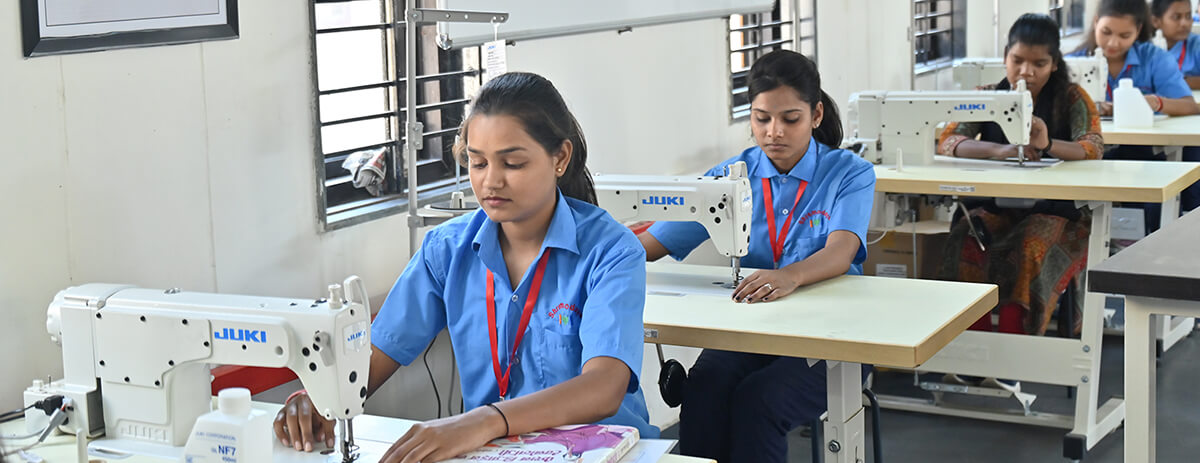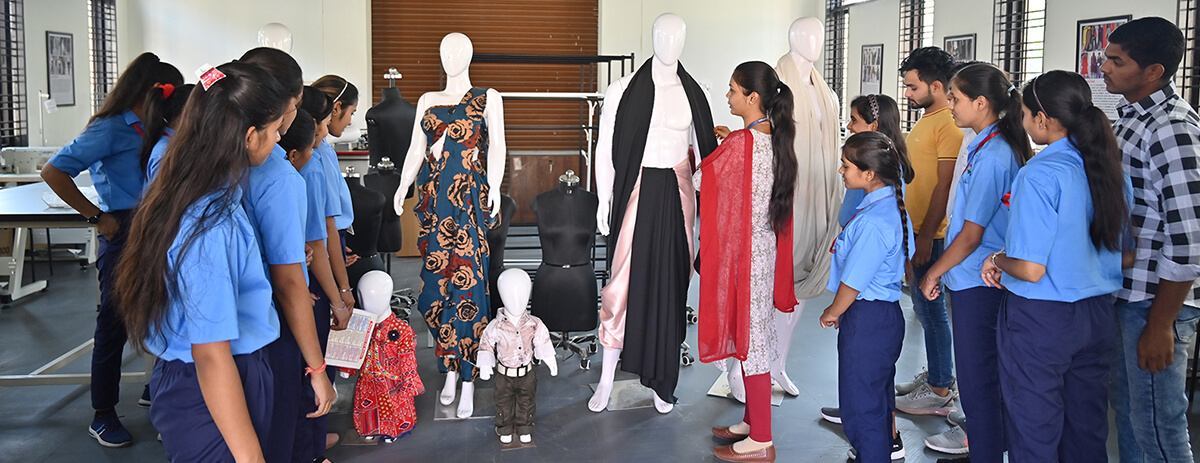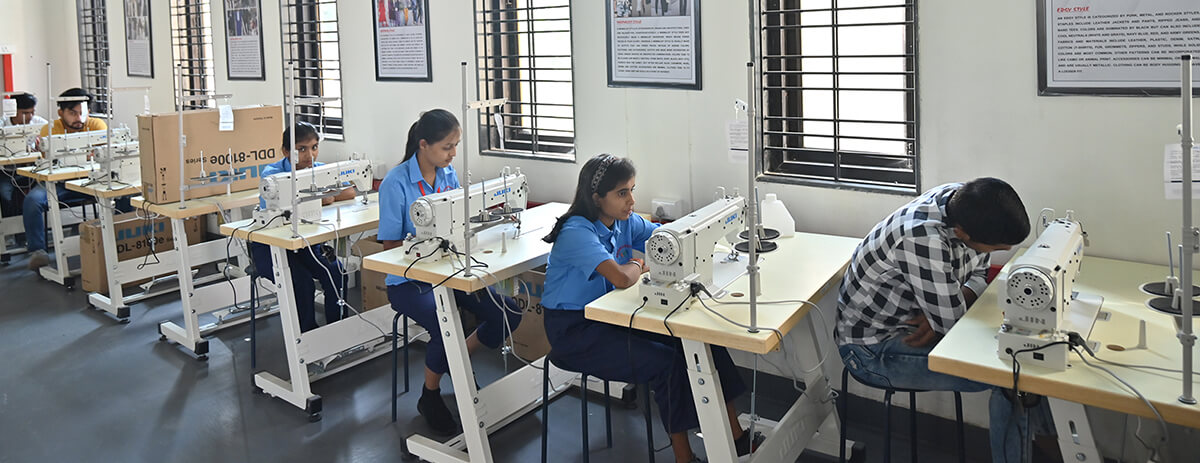FASHION DESIGN & TECHNOLOGY: GENERAL INFORMATION
Click to see more images| Name of the Trade | FASHION DESIGN & TECHNOLOGY (Non-Engineering Trade) |
|---|---|
| Trade Code | DGT/1026 |
| NCO - 2015 | 1026 |
| NOS Covered | NOS:AMH/N1204, AMH/NO103, NOS:AMH/N1010, NOS:AMH/N1211, NOS:AMH/N1201, NOS: AMH/N9403, NOS:AMH/N1947, NOS:AMH/N1948, NOS:AMH/N1203, NOS: AMH/N9404 |
| NSQF Level | Level – 3 |
| Duration of Craftsmen Training | One year (1200 Hours + 150 hours OJT/Group Project) |
| Entry Qualification | 14 years as on first day of academic session. |
| Minimum Age | Passed 10th class examination |
During the one-year duration of "Fashion Design & Technology" trade a candidate is trained on Professional Skill, Professional Knowledge and Employability Skill related to job role. In this trade we encourage each and every student to access and nurture their own natural sense of flair and creativity. We also help them to know that how can they create new ideas, thoughts and also to execute them in real form. In addition to this a candidate is entrusted to undertake project work, extracurricular activities and on job training to build up confidence. The broad components covered under Professional Skill subject are as below:-
FASHION DESIGN & TECHNOLOGY: Year wise Trade Overview
The broad professional skills covered as part of the skill training start with familiarization and identification of tools & sewing machine, sketches of female croquie and design using elements and principle of design in terms of dress. The trainees learn to draw texture and perform fabric rendering. Also develop motifs for various traditional embroideries and perform machine stitches to make different parts as per design. The content also covers different fabrics; designing through Corel draw and working on special effects are also part of the professional components in this part. The professional skill starts sketching different elements of garment. Develop different views of male & female croquie and develop designer wears based on draping techniques. Ensures quality and gets ideas about fashion merchandising and career prospect in the field. Finally, the trainees imparts skill on designing fashion accessories as per latest trend.
The trainee also undergoes two weeks project work at the mid and end of the year which gives them more practical exposure and helps to build up confidence level.
GENERAL
The Directorate General of Training (DGT) under Ministry of Skill Development & Entrepreneurship offers a range of vocational training courses catering to the need of different sectors of economy/ Labour market. The vocational training programmes are delivered under the aegis of Directorate General of Training (DGT). Craftsman Training Scheme (CTS) with variants and Apprenticeship Training Scheme (ATS) are two pioneer schemes of DGT for strengthening vocational training.
Fashion Design & Technology trade under CTS is one of the popular courses delivered nationwide through a network of ITIs. The course is of one-year duration. It mainly consists of Domain area and Core area. The Domain area (Trade Theory & Practical) imparts professional skills and knowledge, while the core area (Employability Skill) imparts requisite core skills, knowledge, and life skills. After passing out the training program, the trainee is awarded National Trade Certificate (NTC) by DGT which is recognized worldwide.
Trainee broadly needs to demonstrate that they are able to:
- Read & interpret technical parameters/documentation, plan and organize work processes, identify necessary materials and tools;
- Perform tasks with due consideration to safety rules, accident prevention regulations and environmental protection stipulations;
- Apply professional knowledge, core skills & employability skills while performing the job, and repair & maintenance work.
- Check the task/assembly as per drawing for functioning, identify and rectify errors in task/assembly.
- Document the technical parameters in tabulation sheet related to the task undertaken.
PROGRESSION PATHWAYS
- Can join industry as Technician and will progress further as Senior Technician, Supervisor and can rise up to the level of Manager.
- Can become Entrepreneur in the related field.
- Can join Apprenticeship programme in different types of industries leading to National Apprenticeship certificate (NAC).
- Can join Crafts Instructor Training Scheme (CITS) in the trade for becoming instructor in ITIs.
- Can join Advanced Diploma (Vocational) courses under DGT as applicable.
COURSE STRUCTURE
Table below depicts the distribution of training hours across various course elements during a period of one year:
| S No. | Course Element | Notional Training Hours |
|---|---|---|
| 1 | Professional Skill (Trade Practical) | 840 |
| 2 | Professional Knowledge (Trade Theory) | 240 |
| 5 | Employability Skills | 120 |
| Total | 1200 |
Every year 150 hours of mandatory OJT (On the Job Training) at nearby industry, wherever not available then group project is mandatory.
| On the Job Training (OJT)/ Group Project | 150 |
|---|
Trainees of one-year or two-year trade can also opt for optional courses of up to 240 hours in each year for 10th/ 12th class certificate along with ITI certification, or, add on short term courses.
LEARNING OUTCOMES
- Interpret and illustrate importance of Fashion designing following safety precautions (NOS:AMH/N1204), (AMH/NO103)
- Sketch fashion croquie of female and design garments with the help of elements using principles of design and colour scheme. (NOS:AMH/N1204)
- Drape, illustrate Fabric rendering and drawing texture. (NOS:AMH/NO1204)
- Apply surface ornamentation with embroidery. (NOS:AMH/N1010)
- Apply basic Stitches, Seams and Edge finishes with operation on Sewing machine. (NOS:AMH/N1211)
- Identify different Fibers and Fabrics along with Weaves and Knits. (NOS:AMH/N1201)
- Create and Design Garments and Accessories in Corel Draw using tools and commands.AMH/N9403
- Create Bodice Block Set & Patterns and construct samples of Design Details. (NOS:AMH/N1204)
- Apply garment details in fashion illustration. (NOS:AMH/N1204)
- Illustrate Male and Female wear on Croquie and develop designer Wears based on draping Technique/ sketches as per fashion & style. (NOS:AMH/N1204)
- Analyse human anatomy with Eight Head theory and different types of body contour. (NOS:AMH/N1947)
- Ensure the Quality of production. (NOS:AMH/N1948), (NOS:AMH/NO103)
- Analyse fashion merchandising, fashion scope and Career Prospect. (NOS:AMH/N1203) (NOS:AMH/N1201)
- Create and Design Fashion accessories as per latest trend. AMH/N9404


